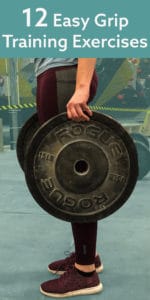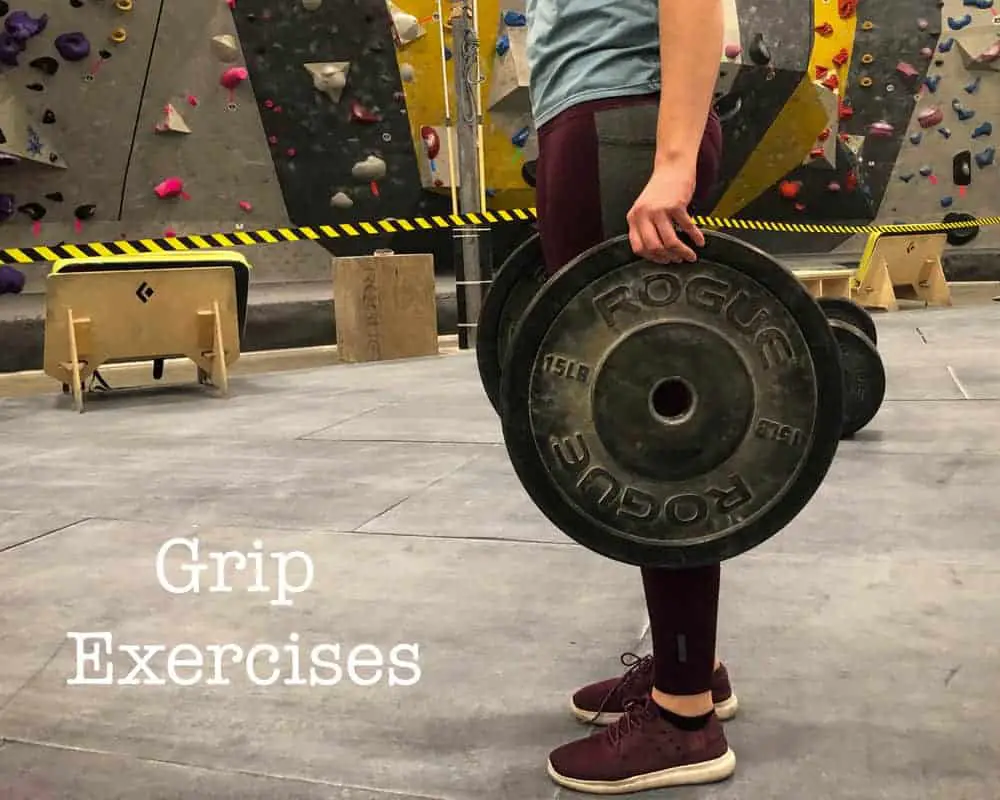Grip training in climbing is one of the most popular and necessary aspects of climbing training. Whether you are just starting to train grip strength or you are looking for something new to add to your grip training regimen, these training exercises are a great way to build your grip strength.
This is a list of 12 great training exercises that come from training books, interviews with professional climbers, social media, Reddit and some of my climbing friends. Some of the training exercises require rock-climbing grip training equipment or other exercise tools but most of them can be found in your local climbing gym or inexpensively online.
Why Should You Strengthen Your Grip
With grip strength being so important, climbers everywhere are trying to find more or new exercises and climbing grip training equipment to increase hand strength and improve climbing performance while at the climbing gym. But is it necessary?
If 50% of your climbing performance was related to one key strength, wouldn’t you consider that necessary to train and build up? Research shows that grip strength directly correlates with climbing performance. This study, for example, about hand-arm strength and endurance as predictors of climbing performance said that relative grip strength accounted for more than 50% of performance in women climbers and less than 30% for men.
Hangboard Training
The hangboard is one of the best rock climbing finger strength equipment and commonly found in all climbing gyms so it is relatively accessible. There are plenty of apps, magazine articles and YouTube videos with recommended hangboard but I really liked Metolius’s training recommendations for beginner, intermediate or advanced training regimens. I included their entry-level 10 min workout below.
Warning: Hangboard training isn’t recommended for new climbers. Misuse and overtraining may cause long-term injuries in your tendons.
What You Need:
- Access to a hangboard for 10 minutes
What You Do:
- 1st minute: 15-second hang on the Jug
- 2nd minute: 1 pull-up on the Round Sloper
- 3rd minute: 10-second hang on the Medium Edge
- 4th minute: 15-second hang w/ 3 shrugs on the Pocket
- 5th minute: 20-second hang w/ 2 pull-ups on the Large Edge
- 6th minute: 10-second hang on the Round Sloper
- 5 knee raises while hanging from the Pocket
- 7th minute: 4 pull-ups on the Large Edge
- 8th minute: 10-second hang on the Medium Edge
- 9th minute: 3 pull-ups on the Jug
- 10th minute: Hang as long as you can on the Round Sloper
Wrist Curls
This exercise is really common among my climbing friends and apparently gymnasts and lifters. In addition to helping build endurance in your hand tendons, it is great for building your forearm muscles, which is an important aspect of your grip. Wrist curls use a small movement making it easy to do anywhere or anytime (while watching TV is my favorite) without interrupting your focus.
What You Need:
- Low weight dumbbell
What You Do:
- While standing or sitting, hold a dumbbell with your elbows supported on something like a table or your knees and keep them bent (45-90 degree angle) with your palms facing down
- Using a slow and controlled movement, constrict forearm up so that your palms move from facing down to facing out and parallel to your body
- Repeat until you are too tired/max out on each arm
- Change your position so you are holding a dumbbell with your palms facing up
- Using a slow and controlled movement, constrict the inside of your forearm so that your palms move from facing up to facing inward and parallel to your body
- Repeat until you are too tired/max out on each arm

If you like Pinches, you’d probably also like this product: Pinch Hold Espresso Cup (affiliate link). I feel like my grip is getting stronger just by drinking Espresso from this cup 😉
Plate Pinch Hold
This is a super simple exercise that many climbing coaches recommend for increasing pinch strength. Pinch climbing holds are one of the most common so pinch strength is extremely important for your climbing performance. Most climbing gyms have weight plates for lifting making this exercise relatively accessible for anyone. In addition, weight plates have different sizes and weights that change the grip width, finger curl amount, and intensity of your exercise easily.
What You Need:
- Weight plates (15-45 pounds depending on your strength)
What You Do:
- While standing, hold a weight plate at your side with your arms straight, shoulders back, with your thumb on one side of the plate and your fingers on the other side (you can also pinch two weight plates together in each hand to make it more difficult)
- Hold the weight plates until your grip fails and place the plates on the ground softly so you don’t accidentally hurt yourself
- Repeat 2xs while trying to increase the amount of time you hold the plates
Campus Board Training
There are many aspects to your grip and campus training helps with dynamic climbing grip and shock load which is important for every climber. Eric Horst, a renowned climber/trainer and author of many climbing training books, did a campus board training exercise video with EpicTV that I highly recommend. I included his beginner exercise below as a good entry point to these types of exercises.
Warning: If you are newer to climbing, only use campus board training under the supervision of a professional and stop if you feel any pain or strain.
What You Need:
- Campus Board
What You Do:
- With both hands, hold onto the third to the bottom handhold with your fingers on top and your thumb on the bottom
- Place both feet on the ground close to the board and lean back so that your arms are straight
- When you are ready to begin, remove one hand and place it at your side
- Begin an inward pull with the engaged hand pulling back your shoulder and bending your elbow to move between the third and second to the bottom handhold of the board
- Repeat this movement for 6-12 movements in 10 seconds or less
- After a brief rest, repeat 2xs with each hand
Dead Hang
Hanging, similar to training with a hangboard, engages every muscle needed for your grip including your hand, arm and core so it is a good way to train your body to engage your whole body instead of just your hand when gripping. Since there are things to hang from everywhere (door frame, tree branch, pull-up bar, etc.), anyone can do it without purchasing or bringing equipment with them.
What You Need:
- Something to hang from that is high enough for you to keep your arm and core straight while holding all of your weight (bending your knees is ok)
What You Do:
- Grip whatever you are hanging from and hold your weight in the air so nothing is touching the ground
- Pull your shoulders back and your chest up to engage your shoulders and core
- Hold this position for 1 minute
- Take a short break
- Repeat 3 times
Offset Hang
This exercise is similar to the dead hang, but it focuses more weight on one hand at a time and is more advanced. It is relatively popular among climbers and lifters and very accessible since it only requires a pullup bar and a towel around the bar to “offset” your hang.
What You Need:
- A pullup bar
- A small hand towel
What You Do:
- Wrap the towel around the pullup bar and grip the two ends of the towel with one hand.
- With your other hand, grip the pullup bar using an overhand grip that’s slightly wider than shoulder-width
- Lift your legs up so that you are holding your weight with both hands, one hand on the bar and one hand around the towel
- Pull your shoulders back and your chest up to engage your shoulders and core
- Hold this position for 1 minute (if you can’t hang for that long, work your way up in increments of 5 to 10 seconds)
- Take a short break
- Repeat 2xs on each hand
Three Limb Climbing
This is one of the more fun exercises involving climbing and also helps you with coordination and dynamic climbing at the same time. Most climbers start out with this exercise by removing one of their feet so that both hands are being used while climbing but as you become better/more advanced, removing one of your hands will be more challenging and force you to engage your grip more.
What You Need:
- Climbing Wall
What You Do:
- Identify a climb that is a couple of grades lower than your current skill level
- Pick one limb (leg or arm) that you will not use during the climb
- Complete the climb without letting the limb you chose to touch the wall
- If you chose your left limb for the first climb, repeat the climb without your right limb.
- Repeat 1-4xs on 3 different climbs
Love These Drills?
Imagine how much easier your climbing journey would be if you had an entire book of drills (77 Drills, to be exact).
77 Drills To Help You Climb Better is NOW AVAILABLE
Fingertip Pushups
Like some of the other exercises, this training engages every muscle involved in your grip so it isn’t just your hands being engaged. If you can’t do pushups than you can still do this exercise by dropping to your knees.
What You Need:
- Nothing – just the ground, which is easily accessible just about anywhere
What You Do:
- Get into a high plank position
- Push your fingers down and pull your palms up so that the only part of your hand on the ground is your fingertips
- Do 10 pushups while on your fingertips
- Take a 30-60 second break and repeat 5xs
Fingertip Plank
Similar to the fingertip pushups, this training engages every muscle involved in your grip so it isn’t just your hands being engaged. This is a great exercise that uses your body weight and gravity, which are the best climbing training tools, but some people choose to wear weight-jackets to make it more difficult.
What You Need:
- Access to the ground… You could probably do this on your bed or on a plane or even on a tree if you want…
What You Do:
- Get into a high plank position
- Push your fingers down and pull your palms up so that the only part of your hand on the ground is your fingertips
- Drop your hands back down so that your palms are touching the ground again
- Repeat 10 times
- After a brief break, repeat 10xs
Seated Row
This exercise is best with a resistance band for grip training, but it can also be done on a row machine if needed. Many people recognize rows for back and core strength, but it also works your shoulders, arms and hands, making it great for engaging everything needed for a good climbing grip.
What You Need:
- A resistance band
- A place to sit (the floor works)
What You Do:
- Wrap a resistance band around your feet and make the ends of the band at your sides
- Straighten your back
- Hold the resistance band at shoulder width with your palms are facing each other
- Pull the resistance band into the sides of your waist
- Repeat 15xs
- Take a 30-60 second break and repeat 3xs
Boa Constrictor Ring Grip
Grip trainers are one of the most popular grip training equipment because it can be done anywhere, is portable and cheap. Like the boa constrictor squeezing its prey, this exercise uses slow and controlled movement. Compared to the common fast grip training with high reps, the slow movement allows you to focus on each muscle used in your grip. Grip trainers are one of the best hand strengtheners for rock climbing and I highly recommend the Ring Grip Trainers. You can use a spring-based grip trainer but the Ring Grip trainer is silent, comfortable to hold and has a clean aesthetic perfect for the gym, your friend’s house, or even at work.
What You Need:
- Ring Grip Trainer – These come at different weight difficulties and I usually use a stiffer one for my full hand part of the exercise and an easier one for the individual finger part of the exercise
What You Do:
- Place your thumb on one side of the ring gripper and your fingers on the other side of the ring; then squeeze.
- Hold a closed hand position for 10 seconds
- Slowly release the tension of your grip (10+ seconds)
- Repeat 5xs on each hand
More Advanced:
- Repeat 2-4 while only using the thumb and 1 finger
- Cycle through each finger with steps 2-4
Power Fingers
Power fingers use the opposite muscles of grip trainers and are extremely important for preventing finger and hand injuries. Some people purchase the actual product called power fingers, which are relatively cheap, compact and portable but I recently learned that some climbers use rubber bands instead. I like power fingers because the packaging that they come in or the trainer itself tells you the weight ratings. This makes it easier for you to see strength improvement as you move up in weight.
What You Need:
- Power Fingers
What You Do:
- Place your fingers and thumb in each hole/ring
- Hold your hand in an open hand position for 10 seconds
- Slowly release the tension of your fingers
- Repeat 5xs
- Repeat 2-4 while only using the thumb and 1 finger
- Cycle through each finger following steps 2-4
- Repeat the exercise with your opposite hand
Bonus Exercise: 5-Second Rule
Your grip strength is important for all types of climbing holds, especially crimp climbing holds so if you want a grip exercise that is specific for crimp holds, check out the 5-Second Rule exercise at the bottom of this article about crimp climbing holds and how to train for them (scroll to the bottom of the page).
Conclusion
There is no question about the importance of grip strength and your climbing performance, so if you want to focus on your grip strength, these are 12 great exercises that many professional climbers and trainers say will help you get the results you want.
Your grip is much more than just your hand strength so make sure that whatever training regimen you use, you included exercises that engage your hands, arms, shoulders and core. Ideally, your entire grip is strong and not just certain aspects of your grip. One way to make sure your overall grip is strong is by singling out each muscle. This is a common method because it ensures that you are providing the same amount of focus to each muscle and it shows you where your weaknesses so you can build an overall stronger grip.
More About Training for Climbing:
- How To Climb More Often Without Getting Injured | Tried And Tested Methods For Recovery
- Lower Body Mobility And Flexibility Challenge
- Neglected Techniques Necessary For V4-V5 Progression
- 17 Footwork Drills For Climbing
- Mental Training For Climbing
- How Often And Hard Should You Climb To Get Gains?
- When Should You Start Hangboarding For Boulder’s
- Is Bouldering When Sore Bad?
- The Top 22 Climbing Techniques And Skills And How To Do Them
- 23 Tips For Climbing Slabs
- When To Flag In Climbing And How-To-Do It (With Videos)
- How To Learn Climbing Technique For Beginners
- What Should You Record In A Climbing Journal?
- Climbing Endurance: Muscle, Skin And Mental Training
- How To Deal With Fear Of Falling
- How Many Days Should You Climb Per Week?
- 5-10 Minute Warm-Up For Climbing
- What Is A Dyno And How To Do It
- What Is A Gaston In Climbing? Powerful Moves For Beginners
- Can Foam Rolling Improve Rock Climbing Performance?
- 7 Things Climbers Should Do On Rest Days For Better Performance
- When Do You Need A Rest Day?
- How To Climb Your Best – Pros And Cons Of Rest Days
- Static Vs Dynamic Climbing Movement: Pros And Cons
- 5 Habits For Healthy Climbing That You Haven’t Thought Of
- 5 Things To Improve Climbing Performance And Sustainability
- 10 Minute Workout Routines For Post Climbing Sessions
- How To Use Climbing Holds: Techniques For Improved Climbing
- A Guide For Climbers: Bouldering Drills 101
- 12 Easy Workouts To Increase Hand And Grip Strength For Climbers
- What Are Undercling Climbing Holds And Why Climbers Love/Hate Them
- What Is A Crimp In Rock Climbing And How To Train For Them
- 7 Common Mistakes in Rock Climbing For Beginners



